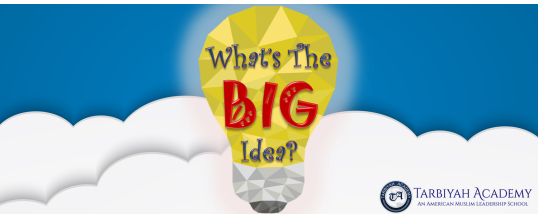
(“What’s The Big Idea” is a series of posts detailing TA’s educational philosophy; this is part one)
“Every school says it’s going to be different. Why does Tarbiyah Academy think it’s going to be different?”
There is a lot that makes Tarbiyah Academy different. One of those things is concept-based learning.
I want you to think about a regular school day in your child’s classroom. Your child will most likely go from one 45-minute class to another. In English he may study about past and present tense verbs, in science about gasses, solids, and liquids, and in math about ratios and percentages. This subject-based classroom is compartmentalized, each having it’s own distinct and separate topic. Each subject is content heavy, with few connections made between disciplines or to the real world. A curious child questions why he is learning, “Why do I even have to learn grammar!? I’m going to be an Engineer.” Or “Why do I need to worry about multiplication tables!? I’m going to be an artist.” These are questions that we’ve all heard before; we might even have asked them ourselves.
In a concept-based classroom, however, learning is trans-disciplinary, transcending subject-specific topics, spanning multiple disciplines. According to Dr. Lynn Erickson, a renowned leader in concept based classrooms and the author of the acclaimed “Concept-based Curriculum and Instruction: Teaching Beyond the Facts“, concept-based instruction is driven by “big ideas” rather than subject-specific content.
“By leading students to consider the context in which they will use their understanding, concept-based learning brings ‘real world’ meaning to content knowledge and skills.”
Learning in context transforms your child from someone who is a mere consumer of knowledge to a producer of knowledge. In a concept-based classroom, content is secondary to the “big idea.” In this classroom, instead of learning only subject specific facts and topics, the student contextualizes her learning through the concept of “Change” as an example. In that same English classroom, the child discovers language as it changes in time (past vs present tense). In science, he identifies change in states of matter (solids, liquids, and gasses). In math, he quantifies change using ratios and percentages. The mere repetition of the word “change” from one class to another naturally links in the child’s mind the topics across the disciplines. The student is no longer learning about facts in a vacuum (i.e. verbs, states of matter, ratios, and percentages). He learns these facts in the context of our ever-changing world. This allows him to connect the subject-specific content in the classroom to the world around him. In this way, students no longer question WHY they are learning, or how it will help them become engineers or artists. The “why” is seamlessly built into the lesson through the Big Idea.
Regardless of whether your child’s classroom is concept-based or traditional, my advice to you is to become your child’s educator and advocate. Get to know your child’s classroom. Get to know the teacher’s philosophy and the school’s educational vision. Don’t ever hesitate to encourage your child to always look for that “Big Idea.”
Note: I’ve thought long and hard about this week’s blog topic. I find myself often conflicted – caught between the science of education and the parent’s perspective. A perspective which often underestimates and undervalues the legitimacy of using “best practices” in the classroom. So for the next few blogs, I will attempt to inform parents on educational best practices. Please feel free to email me at hos@tarbiyahacademy.org if you’d like to comment on this blog or have any suggestions for future blogs.
ShareAUG
